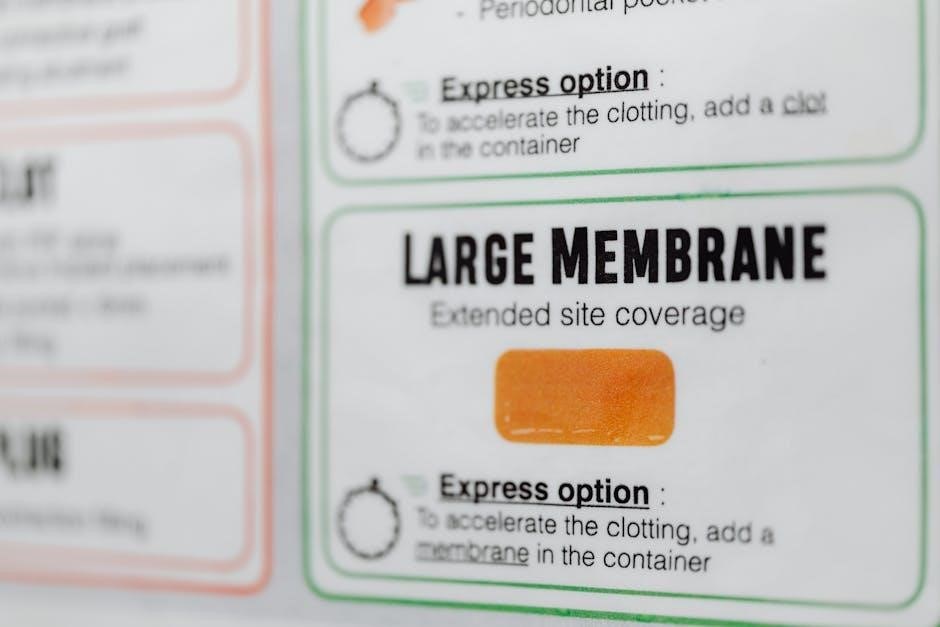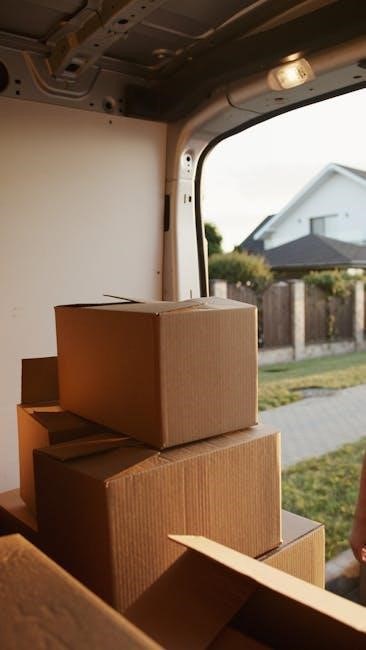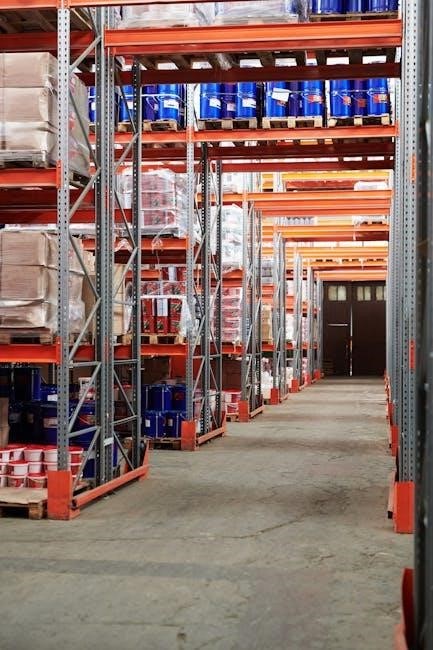Proper package instructions ensure safe transportation and delivery. Use sturdy materials like corrugated boxes and bubble wrap, secure items tightly, and follow carrier guidelines for optimal packaging success.
1.1 Importance of Proper Packaging
Proper packaging is essential to protect items during transit, preventing damage and ensuring safe delivery. Sturdy materials like corrugated boxes and bubble wrap help absorb shocks and stresses. Securely sealing packages prevents shifting, reducing the risk of breakage. Proper labeling and documentation ensure timely delivery and minimize delays. Improper packaging can lead to damaged goods, additional costs, and customer dissatisfaction. By following packaging guidelines, you safeguard your items and ensure a smooth shipping experience for both sender and recipient. Always prioritize durability and precision when preparing your packages for shipment.
1.2 Overview of Packaging Materials
Common packaging materials include corrugated cardboard boxes, bubble wrap, foam inserts, packing peanuts, and paper. Corrugated boxes provide structural support and protection, while bubble wrap and foam cushion fragile items; Packing peanuts fill empty spaces, preventing movement during transit. Paper-based materials, like packing paper, offer lightweight protection. These materials are widely available and can be sourced from carriers like FedEx, UPS, or USPS. Proper selection ensures items are securely packed, reducing damage risks and ensuring safe delivery. Always choose materials that align with the item’s weight, size, and fragility for optimal protection.
1.3 Basic Steps in Packaging
Packaging begins with selecting a sturdy box that fits the item snugly. Wrap fragile items in bubble wrap or foam for protection. Place the item in the box, filling empty spaces with packing peanuts or paper to prevent movement. Seal the box securely with packing tape. Attach clear labels with the recipient’s address and any special handling instructions. Always follow carrier guidelines for optimal protection and delivery. Proper packaging ensures safety during transit and minimizes damage risks.

General Packaging Guidelines
Use sturdy boxes, appropriate packing materials, and ensure items fit snugly. Secure packages with tape, label clearly, and follow carrier guidelines for safe and efficient shipping.
2.1 Choosing the Right Box Size
Selecting the correct box size is crucial for safe shipping. Measure the item accurately to ensure a snug fit, avoiding oversized boxes that may cause shifting. Use padding like bubble wrap or paper to fill empty spaces, preventing movement. A well-fitted box reduces damage risk and ensures secure transit. Proper sizing also minimizes shipping costs and enhances protection. Always verify carrier guidelines for box dimensions and weight limits to avoid issues during transport.
2.2 Proper Use of Packing Materials
Properly using packing materials ensures item safety during transit. Use bubble wrap or foam inserts for fragile items, and fill empty spaces with packing peanuts or paper. Wrap items individually to prevent friction and damage. Securely seal boxes with strong tape, ensuring no gaps. Avoid overloading packages, as this can lead to material failure. Always follow carrier guidelines for material usage to guarantee safe and efficient shipping. Proper packing minimizes the risk of damage and ensures your items arrive intact at their destination.
2.3 Securing the Package
Securing the package is crucial for safe transit. Use strong packing tape to seal seams and edges, ensuring no gaps remain. Apply tape in a crisscross pattern for added strength. Avoid overloading the package, as this can compromise its integrity. Place the shipping label in the center of the package, away from seams or tape. Ensure all flaps are tightly closed and reinforced if necessary. Properly securing the package minimizes the risk of damage during shipping and ensures it reaches its destination in perfect condition.
Specific Packaging Materials
Choose appropriate materials like corrugated boxes, bubble wrap, foam inserts, and packing peanuts to ensure items are well-protected during transit. These materials provide cushioning and support, preventing damage and ensuring safe delivery of the package.
3.1 Corrugated Cardboard Boxes
Corrugated cardboard boxes are the most commonly used packaging material due to their durability and versatility. They are available in various sizes and thicknesses, making them suitable for both lightweight and heavy items. Double-walled or triple-walled options provide extra protection for fragile or bulky goods.
When selecting a box, ensure it fits the item snugly, leaving minimal empty space. This helps prevent movement during transit. Custom sizes can also be ordered to meet specific shipping needs, ensuring optimal protection for the contents.
3.2 Bubble Wrap and Foam Inserts
Bubble wrap and foam inserts are essential for protecting fragile items during shipping. Bubble wrap cushions items from shocks and impacts, while foam inserts provide a snug fit, preventing movement within the box. Use bubble wrap with larger bubbles for heavy items and smaller bubbles for delicate surfaces. Foam inserts can be custom-cut to fit specific items, ensuring maximum protection. Both materials are lightweight, helping to keep shipping costs low while maintaining high-level protection for your package.
3.3 Packing Peanuts and Paper
Packing peanuts and paper are cost-effective materials for protecting items during shipping. Packing peanuts fill empty spaces in boxes, preventing movement and shock damage; Paper, such as packing paper or kraft paper, is ideal for wrapping fragile or delicate items. Both materials are lightweight, reducing shipping costs. For eco-conscious options, biodegradable peanuts or recycled paper can be used. Properly securing items with tape ensures they remain safe during transit. These materials are versatile and essential for achieving secure and damage-free packaging.

Safety Tips for Packaging
Always avoid overloading packages, as this can cause damage. Protect fragile items with sufficient padding and ensure proper closure to prevent leaks or tampering during transit.
4.1 Avoiding Overloading the Package
Avoid overloading your package to prevent damage during transit. Use sturdy materials and ensure items fit comfortably without excessive strain on the box. Distribute weight evenly and avoid adding unnecessary items. Check the weight limits specified by carriers like FedEx or UPS to ensure compliance. Overloading can lead to package tearing, bursting, or additional shipping costs. Securely close the package to maintain integrity and prevent contents from shifting. Properly sealing and balancing the load ensures safe delivery and avoids potential service issues.
4.2 Protecting Fragile Items
When packaging fragile items, use materials like bubble wrap, foam inserts, or packing peanuts to cushion them. Place fragile items in the center of the box, away from edges and corners. Ensure the box is sturdy and specifically designed for fragile goods. Fill any empty spaces with padding to prevent movement. Seal the package securely to avoid shifting during transit. Always label the package as “Fragile” and consider double-boxing for extra protection. Proper cushioning and placement are critical to preventing damage and ensuring safe delivery.
4.3 Ensuring Proper Closure
To ensure a package is properly sealed, use high-quality packaging tape, applying it evenly across all seams. Reinforce closures with additional tape for durability. Ensure labels are clear and protected from damage. Avoid using damaged or worn-out boxes, and consider tucking tape ends under flaps for extra security. Follow carrier guidelines for sealing to prevent issues during transit. Proper closure ensures the package remains intact, protecting its contents and facilitating smooth delivery.

Step-by-Step Packaging Process
Start by preparing the box, placing the item inside, and adding padding like bubble wrap or foam. Securely seal with packaging tape, ensuring a tight, even application. Finally, inspect the package for any gaps or weaknesses to ensure it’s ready for shipping.
5.1 Preparing the Item
Before packaging, ensure the item is clean and dry. Remove any loose parts or accessories and store them separately. For fragile items, wrap them in bubble wrap or foam inserts. If the item has sharp edges, cover them with protective padding. Secure any moving parts or liquids to prevent leakage. Place smaller items in sealed bags to avoid loss. Ensure the item fits snugly inside the box, leaving no space for movement. This step is crucial for safeguarding the item during transit.
5.2 Assembling the Box
Start by selecting a box that fits the item snugly. Place the item in the center of the box, ensuring even spacing on all sides. Fill empty spaces with packing materials like bubble wrap or packing peanuts to prevent movement. Fold and tuck flaps securely, then seal the box with strong packing tape. Apply additional tape in both directions for added reinforcement. Ensure the box is not overloaded, as this can compromise its structural integrity during shipping. Proper assembly ensures the item remains protected throughout transit.
5.3 Final Inspection
Before sealing, inspect the box for gaps or weak points. Ensure all items are properly cushioned and the box is not overloaded. Verify the shipping label is accurate and clearly visible. Check for any signs of damage or openings. Securely close the box with strong tape, ensuring all flaps are tightly sealed. Double-check that the package meets carrier-specific requirements. Finally, handle fragile items with care and confirm all packaging materials are correctly used. A thorough inspection ensures a safe and secure shipment, reducing the risk of damage or delivery errors.

Carrier-Specific Packaging Instructions
Always follow the specific packaging rules of your chosen carrier. FedEx, UPS, and USPS have guidelines for box sizes, weight limits, and proper labeling to ensure smooth delivery.
6.1 FedEx Packaging Requirements
FedEx requires proper packaging to ensure safe delivery. Use sturdy boxes with secure closures, adequate cushioning, and clear labeling. Fragile items need extra protection, and packages must not exceed weight limits. Properly affix shipping labels and avoid overloading. Follow FedEx guidelines for specific item types, such as electronics or perishables. Use approved materials and ensure packages are sealed tightly. Refer to FedEx’s official packaging guide for detailed instructions and compliance with their shipping policies. Proper packaging helps prevent damage and ensures timely delivery.
6.2 UPS Packaging Guidelines
UPS emphasizes proper packaging to prevent damage and ensure timely delivery. Use sturdy, corrugated boxes and adequate cushioning materials like bubble wrap or packing peanuts. Avoid overloading packages and ensure secure closure with packing tape. Label packages clearly and correctly, including address and handling instructions. Follow UPS guidelines for specific items, such as fragile or perishable goods. Refer to UPS’s official packaging tips for detailed instructions. Proper packaging ensures safety, reduces claims, and meets carrier requirements for efficient shipping.
6.3 USPS Packaging Recommendations
USPS recommends using sturdy boxes and adequate cushioning to protect items during transit. Ensure packages are properly sealed with packing tape and labels are clear. Avoid using prohibited materials and comply with size and weight limits. Fragile items require extra padding, and perishables must be packaged to prevent spoilage. Use USPS-approved packaging for special items like lithium batteries. Follow USPS guidelines for address formatting and handling instructions. Proper packaging ensures safe delivery and compliance with postal regulations, reducing the risk of damage or delays.

Special Care for Fragile or Perishable Items
Use extra cushioning like bubble wrap or foam inserts for fragile items. Perishables require thermal packaging to maintain temperature. Ensure all items are securely sealed to prevent damage during transit.
7.1 Packaging Fragile Items
When packaging fragile items, use sturdy materials like corrugated cardboard boxes and ample bubble wrap or foam inserts. Wrap each fragile item individually, ensuring no direct contact. Place items in the center of the box, surrounded by cushioning. Avoid overloading the box, as this can increase the risk of damage. Securely seal the package with high-quality tape and label it as “Fragile” on all sides. Double-check that the package is properly closed and test it gently to ensure stability during transit.
7.2 Packaging Perishable Goods
When packaging perishable goods, use thermal packaging materials to maintain appropriate temperatures. Include insulation, ice packs, or dry ice if necessary. Seal items in airtight, leak-proof containers to prevent spoilage. Place items in a sturdy box with sufficient cushioning to absorb shocks. Label the package as “Perishable” and ensure it meets carrier-specific guidelines for handling sensitive goods. Consider using biodegradable or recyclable materials to reduce environmental impact. Always check the expiration dates and ensure timely delivery to preserve the integrity of the perishable items.
7.3 Using Thermal Packaging
Thermal packaging is essential for maintaining consistent temperatures during transit. Use insulated boxes, gel packs, or dry ice to regulate heat or cold. Ensure all perishable items are tightly sealed in airtight containers to prevent leakage. Surround items with thermal insulation materials to protect against temperature fluctuations. Follow carrier guidelines for handling thermal packages, especially for perishables. Consider eco-friendly thermal packaging options to reduce environmental impact. Properly label the package with handling instructions to ensure safe delivery and maintain product integrity throughout the shipping process.

Legal and Regulatory Considerations
Ensure compliance with shipping laws and regulations. Declare restricted items accurately to avoid legal issues. Properly label packages for customs clearance and adhere to carrier-specific requirements.
8.1 Compliance with Shipping Regulations
Compliance with shipping regulations ensures legal and safe transport of packages. Adhere to carrier-specific guidelines, declare restricted items accurately, and follow proper documentation procedures. Verify local, national, and international shipping laws to avoid penalties. Properly label packages, including customs forms for international shipments, and ensure all items meet safety standards. Familiarize yourself with prohibited and restricted items lists to prevent delays or confiscation. Compliance protects both sender and recipient, ensuring smooth delivery and avoiding legal repercussions.
8.2 Proper Documentation
Proper documentation is crucial for smooth package delivery. Ensure all shipping labels, invoices, and receipts are included and clearly visible. Accurately declare package contents, weight, and value to avoid customs delays. Use legible handwriting or printed labels, and attach documents securely. Include any required permits or certifications for restricted items. Double-check addresses and tracking information to prevent misdelivery. Proper documentation helps prevent disputes, ensures compliance, and streamlines the shipping process for both sender and recipient.
8.3 Restricted Items
When shipping, it’s essential to identify and comply with regulations for restricted items. These include hazardous materials, perishables, and prohibited goods. Check carrier-specific lists for items like batteries, liquids, or firearms. Properly declare and package restricted items to avoid delays or penalties. Use approved packaging and labeling, and ensure compliance with local and international laws. Failure to adhere to these guidelines may result in shipment refusal or legal consequences. Always verify restrictions before shipping to ensure smooth delivery and avoid potential issues.

Environmental Impact of Packaging
Using eco-friendly packaging materials reduces waste and minimizes environmental harm. Opt for recyclable or biodegradable options to significantly reduce your packaging’s ecological footprint and promote sustainability.
9.1 Eco-Friendly Packaging Options
Switching to eco-friendly packaging helps reduce environmental impact. Consider using recyclable materials like corrugated cardboard, biodegradable packing peanuts, or mushroom-based packaging. Opt for minimal packaging designs to cut down on excess materials. Reusable containers and compostable wraps are also excellent alternatives. When possible, choose materials with low carbon footprints or those made from recycled content. Properly recycling packaging materials further supports sustainability. By adopting these practices, businesses and individuals can significantly minimize their environmental impact while ensuring items remain well-protected during transit.
9.2 Reducing Waste
Minimizing waste in packaging is essential for sustainability. Use minimal packaging materials, ensuring they are necessary and appropriately sized for the item. Opt for recyclable or biodegradable materials instead of single-use plastics. Avoid excess bubble wrap or packing peanuts when possible. Reuse boxes or packaging supplies when feasible. Properly dispose of non-recyclable materials and encourage recycling programs. Reducing waste not only benefits the environment but also lowers shipping costs and enhances brand reputation by promoting eco-conscious practices.
9.3 Recycling Packaging Materials
Recycling packaging materials is crucial for minimizing environmental impact. Use recyclable materials like cardboard, paper, and biodegradable plastics. Participate in carrier recycling programs or drop off packaging at local recycling centers. Remove non-recyclable elements such as bubble wrap and tape before recycling. Educate consumers on proper disposal methods to increase recycling rates. Businesses can implement take-back programs for used packaging, fostering sustainability and reducing landfill waste. Encourage the use of reusable materials to promote a circular economy and reduce resource consumption.

Troubleshooting Common Packaging Issues
Address packaging problems like leaks, damage, or delays. Inspect for weak seals, improper material use, or insufficient cushioning. Resolve errors promptly to ensure timely delivery and customer satisfaction.
10.1 Addressing Leaks or Damage
Inspect packages for leaks or damage before shipping. Ensure all items are securely wrapped with bubble wrap or foam inserts to prevent movement. Use sturdy, corrugated cardboard boxes and seal edges with strong adhesive tape. For fragile items, double-boxing is recommended. Check for weak seals or improper cushioning, which can lead to damage. Addressing these issues promptly helps prevent shipping delays and ensures items arrive in perfect condition. Follow carrier-specific guidelines for packaging fragile or perishable goods to minimize risks during transit.
10.2 Handling Lost or Delayed Packages
If a package is lost or delayed, track its status using the provided tracking number. Contact the carrier’s customer support for assistance. Provide detailed information, including the tracking number and shipment details. Follow up regularly for updates. Use delivery instructions to specify alternative delivery options. Review packaging and documentation to ensure compliance with shipping guidelines. Addressing these issues promptly helps resolve concerns and ensures a smooth delivery process. Tracking and communication are key to resolving lost or delayed package issues efficiently.
10.3 Resolving Packaging Errors
Address packaging errors by identifying the root cause, such as insufficient padding or incorrect box size. Re-pack items using appropriate materials like bubble wrap or foam inserts. Ensure proper closure with packing tape and verify labeling accuracy. Consult carrier guidelines for specific requirements. Double-check item preparation and packaging steps to prevent recurrence. Inspect the package for damage or gaps before reshipping. Properly addressing errors ensures safe transit and avoids additional delays or damage to the contents. Always follow carrier-specific instructions for resolving packaging issues efficiently.

Resources for Further Assistance
Visit UPS, FedEx, and USPS websites for detailed packaging guides. Explore tutorials, customer support contacts, and official documentation to ensure compliance with shipping requirements and improve packaging skills effectively.
11.1 Packaging Tutorials and Guides
Utilize online resources like UPS, FedEx, and USPS websites for step-by-step packaging tutorials. These guides offer detailed instructions on choosing materials, securing items, and preparing shipments. Additionally, YouTube channels and shipping blogs provide hands-on demonstrations for various packaging scenarios. Many carriers also offer downloadable PDF guides and video tutorials to help you master packaging techniques. These resources are essential for ensuring compliance with carrier requirements and improving your packaging skills. Regularly reviewing these materials can help you stay updated on best practices and optimize your shipping processes efficiently.
11.2 Customer Support Contacts
For assistance with packaging, contact carrier customer support teams. FedEx, UPS, and USPS offer phone, live chat, and email support. Visit their official websites for contact details. Additionally, physical stores provide in-person guidance. These resources help resolve packaging issues, track shipments, and ensure compliance with shipping regulations. Utilizing these support channels can enhance your packaging efficiency and address any concerns promptly. They are invaluable for troubleshooting and ensuring a smooth shipping experience.

